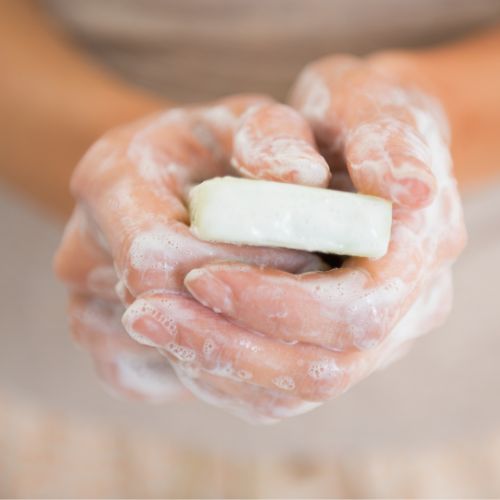7 Main Causes of Weird Feeling in the Female Urethra.
Our content is not intended nor recommended as a substitute for medical advice by your doctor. Use for informational purposes only.
Common causes of a weird feeling in the female urethra include:
- Chemical irritants such as soaps and feminine hygienic products.
- UTI (urinary tract infection).
- Urethritis.
- Urethral pain syndrome (UPS).
- Post-menopausal Vulvovaginal atrophy.
- Vaginitis or cervicitis.
- Passage of a stone through the urethra.
- Others include pelvic inflammatory disease, urethral diverticulum, urethral trauma, etc.
The most common causes of a weird feeling in the female urethra are chemical irritants and UTIs. Other causes are less frequent, such as urethral pain syndrome, urethral trauma, vaginitis, etc.
Keep reading this article to learn more about the symptoms and diagnosis of each of the common causes of abnormal urethral symptoms in females.
1. Chemical irritation (Commonest cause of weird feeling in the female urethra).
The urethral opening may become irritated in those who overuse soaps or other chemical irritants.
Common irritants include (reference):
- Soap
- Bubble baths
- Feminine hygiene products
- Spermicide-coated condoms and diaphragms.
- Synthetic fibers in the underwear.
Symptoms & Diagnosis:
- History of overwashing or switching to a new soap type or hygiene product.
- Continuous burning or strange sensation in the urethra.
- The weird sensation worsens when you pee (Dysuria).
- Also, this strange sensation often comes and goes with bathing, overwashing, or using spermicide-coated condoms or diaphragms.
- There may be redness or itching around the urethral opening.
- Chemical urethritis doesn’t lead to fever, lower abdominal pain, or urethral discharge.
- The urine analysis is often free and doesn’t reveal UTI.
What to do:
- Eliminate the irritant: the only definitive treatment of chemical urethritis is to avoid the offending soap or hygienic product.
- Petroleum jelly: studies show that applying petroleum jelly around the urethral area improves the burning sensation dramatically and prevents further irritation.
- Use 100% cotton fabric underwear.
- Don’t over-wash or under-wash; limit the unnecessary use of soap or hygienic products.
- If the burning pain is severe, your doctor may prescribe phenazopyridine (Pyridium) to ease the pain.
2. UTI (Cystitis).
Urinary tract infections (especially cystitis) are most common in females due to the shorter urethra (which is severe as a route for the bacteria entering the bladder from outside) (reference).
Most cases of UTI have mild symptoms such as burning urination, bladder pain, and urethral discomfort.
Symptoms & diagnosis:
- Dysuria: burning or weird sensation in the urethra when you pee.
- Urgency: sudden severe urgency to pee.
- Frequency: Frequent urge to pee but only a small amount of urine comes out.
- Suprapubic (lower abdominal) pain.
- Turbid (cloudy) urine may also be present.
- The symptoms may be very mild, with a strange feeling in the bladder and urethra.
- Also, UTI may become complicated (reaching the kidneys), causing high fever, flank pain, chills, etc.
- The diagnosis is often established by urine analysis and culture.
What to do:
UTI is a very common cause of abnormal urinary symptoms in females. Consult your doctor to confirm the diagnosis if you have symptoms consistent with UTI.
UTIs are treated mainly by antibiotics (such as Nitrofurantoin and Trimethoprim-sulfamethoxazole).
An over-the-counter urinary analgesic such as Oral phenazopyridine may help relieve the dysuria and uncomfortable urethral sensations.
3. Urethritis.
Urethritis is an inflammation limited to the urethra. It is more common in males. However, it may also occur in females (often associated with vaginitis or cervicitis).
The most common organisms include (reference):
- Neisseria gonorrhea: the leading cause of urethritis. It is a sexually-transmitted disease.
- Chlamydia Trachomatis: the most common non-gonococcal cause of urethritis.
- Tricholoma vaginalis (a protozoal infection).
- Herpes simplex virus urethritis.
- Adenovirus.
- H. influenza bacteria.
- Candida species (fungal infection) and others.
Symptoms & diagnosis:
- Urethritis can be completely asymptomatic or with only a weird or strange sense of discomfort in the urethra.
- Urethral pain (the burning sensation that is greater when you pee).
- Urethral discharge (the severity and nature of the discharge depending on the causative organism):
- Gonorrhea causes plenty of pus or pus and mucus discharge from the urethra that comes out without urination.
- Chlamydia trachomatics discharge is often scanty and watery. In females, it is often associated with vaginitis and cervicitis.
- Mycoplasma genitalium is often asymptomatic but may cause purulent (pus) discharge from the urethra.
- Herpes simplex urethritis intense dysuria (urethral pain) without significant discharge.
- Dysuria (painful urination).
- Associated vaginitis and cervicitis, sometimes with associated vaginal discharge, itching, vaginal bleeding, bleeding after sex, etc.
- Most types of urethritis are sexually transmitted, So check with your partner if he has similar symptoms.
- In females, gonorrhea may spread to the genital system causing pelvic inflammatory disease (infection of the uterus, fallopian tubes, etc.).
- The diagnosis of urethritis is based mainly on visualizing the discharge. However, tests may also be needed to detect the cause (urethral swab, urethral culture, etc.).
What to do:
Consult your doctor immediately if you have abnormal urethral or vaginal discharge. The main treatment of infectious urethritis is antibiotics.
Aldo, your partner, should be evaluated if you have confirmed infectious urethritis (most of the organisms are sexually transmitted).
4. Urethral Pain syndrome.
Urethral pain syndrome is a recurrent or persistent pain or discomfort in the bladder and urethra in females during the daytime without evidence of UTI or other urinary diseases.
The exact cause is unknown. However, some possible risk factors include prior sexually transmitted diseases, spicy foods, caffeine, chemical irritants, etc.
Symptoms & diagnosis:
- It typically affects females aged between 13 and 70 years old.
- Lower abdominal (bladder) pain or discomfort.
- Constant discomfort or weird feeling in the urethra.
- Burning sensation during urination (dysuria).
- The pain is often worse during the daytime and less at night.
- The pain or discomfort is often partially relieved after you pee.
- Associated symptoms (urethral pain syndrome is considered a part of a myofascial pain syndrome):
- Painful intercourse.
- Painful menses.
- Bowel habit changes (constipation or diarrhea).
- Chronic fatigue and tender muscles all over the body.
- The diagnosis of urethral pain syndrome is often a diagnosis of exclusion. Your doctor often will not find any evidence of UTI, urethritis, or other causes of urethral pain.
Your doctor may prescribe antidepressants, muscle relaxants, local corticosteroids, or anesthetics to help the pain.
Behavioral therapy such as meditation, cognitive behavioral therapy, and hypnosis may also help.
5. Vaginitis or cervicitis.
In adult females, the normal vaginal secretions are white or transparent, odorless, and scanty (1-4 mL of fluid per 24 hours) (reference).
Inflammation of the vaginal leads to abnormal vaginal secretions. The inflammation inside the vaginal cavity or cervix may extend to the outmost part of the urethra leading to weird or strange feelings in the urethra.
The three most common causes of vaginitis according to the type of secretion (reference):
- Scanty secretions: nonspecific vaginitis (the most common type).
- White & cheesy: candida infection (a famous fungal infection).
- Thick & green: gonorrheal infection.
6. Post-menopausal atrophic vaginitis or vulvovaginal atrophy.
Females after menopause have much less estrogen. As a result, the vaginal lining becomes very thin (atrophic).
The thin vaginal lining leads to a higher risk of inflammation and infection (reference). The atrophic vaginal lining leads to dryness which may extend to the urethra and cause urethral pain, discomfort, or burning sensation.
Symptoms of atrophic vaginitis:
- Dryness in the vulvovaginal area after menopause.
- Burning or irritation or strange sensation in both the vaginal and the urethra.
- Painful intercourse (due to the lack of lubrication).
- Dysuria, UTI symptoms.
- Vaginal infection may also occur, leading to abnormal vaginal secretions (white, green, or thick secretions with abnormal odor).
7. Passage of a stone through the urethra.
Passing a stone with urine may lead to minor trauma (injury to the inner wall of the urethra).
These minor abrasions secondary to the passage of the stone may cause urethral pain or a burning sensation that lasts for days after the stone passage.
Symptoms:
- History of passing a stone with urine.
- Severe burning pain in the urethra, especially with urination (dysuria).
- Bloody urine may occur due to the injury to the urethra.
- Prior history of flank or bladder pain during the passage of the stone in the ureter.
- Other urinary symptoms, such as urgency and frequency, may also exist.
8. Others.
- Pelvic inflammatory disease.
- Trauma to the urethra (commonly due to vigorous sexual activities).
- Psychogenic causes.
- Urinary tract cancer.
- Urethral stricture.
- Urethral diverticulum.
- Radiation exposure.
- Skin diseases such as lichen sclerosis.
- Virginal vaginal ulcers.
- Allergic diseases such as irritant contact dermatitis.
- Labial adhesions around the urethral opening (in young prepubertal females.
- Recent urinary catheterization.
- Evidence-based
- Written by a doctor.
MD, Internal Medicine and Nephrology specialist.

Dr. Esraa A. MagidAuthor
MORE INSIGHTS





